The secondhand online marketplace continues to grow with each passing day. Two of the major players in the online selling world are eBay and Mercari.
When comparing the two platforms, each has its own strengths and weaknesses.
In this post, we will go over everything you need to know with an in-depth side-by-side comparison of Mercari vs eBay.
We will explore the user base, what to sell, shipping policies, fees, and so much more. Stay tuned to see which platform will come out on top.
Jump to:
User Base
In this section, we will go over how many users, also known as potential buyers, are on each platform.
eBay User Count
eBay has a lot more time and history as a platform when compared to Mercari, as eBay was founded back in 1995. Mercari was new on the secondhand online store scene in 2013.
The extra time and history for the development of the platform is evident when considering monthly active users. eBay has a large audience consisting of approximately 150 million monthly active users.
Mercari User Count
Mercari, on the other hand, has 20 million monthly active users.
This may also be attributed to Mercari being an e-commerce platform that is only offered to buyers and sellers in the United States, while eBay draws a global audience.
However, I wouldn't count Mercari out. Although seemingly small, Mercari can generate some serious sales for sellers.
Next, let's discuss the listing process on Mercari vs eBay.
Listing On Mercari vs eBay
In this section, we will go over all things listing including pictures, titles, fields to fill in, setting a price and shipping information, and more.
Pictures On eBay
eBay allows the most pictures out of all the secondhand eCommerce platforms. On eBay, sellers can add up to 24 pictures of their items to their listings.
In addition to pictures, eBay sellers can also upload one video to each listing to show off their item.
Pictures On Mercari
Mercari allows half of the pictures that eBay does: 12 pictures. Mercari does not yet support the use of videos within its listings.
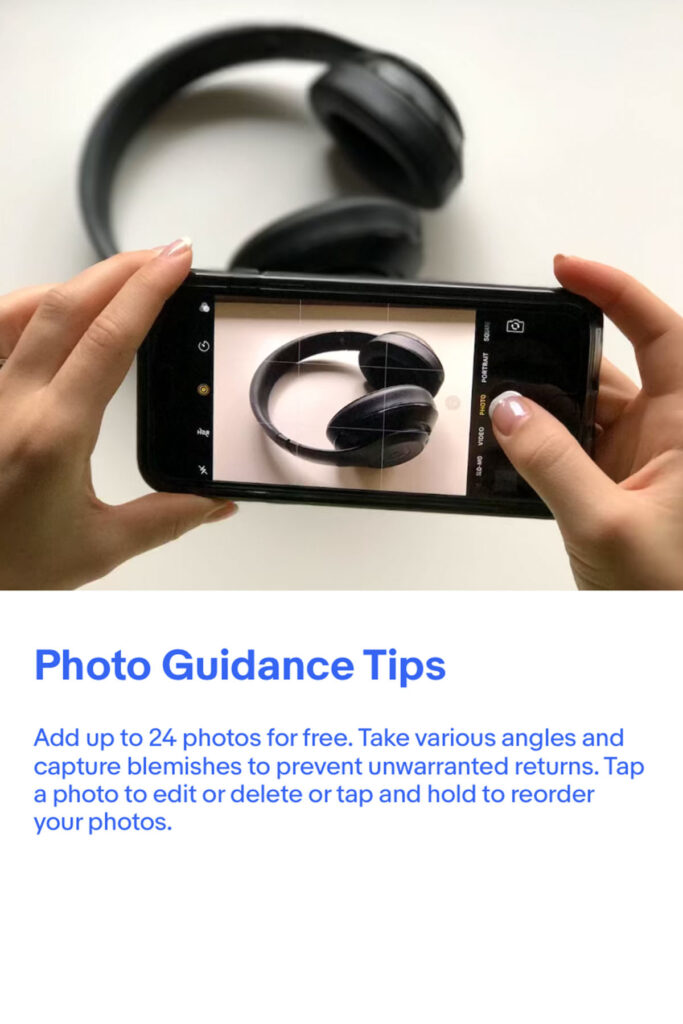
Titles On eBay And Mercari
On both eBay and Mercari, you can have 80 or fewer characters in your title. This includes both letters and spaces. Use these characters to the best of your ability, getting as close to 80 as possible.
Item Specifics On eBay
eBay has the most picture slots of any platform, along with the most required and optional listing fields.
For example, for a pair of pants, eBay requires the following:
- Title
- Description
- Condition
- Brand
- Color
- Size Type
- Size
- Department
- Style
- Type
- Price
- Quantity
- Shipping Policy
eBay also has the following optional fields:
- Theme
- Pattern
- Fabric Type
- Rise
- Features
- Material
- Fabric Wash
- Performance/Activity
- Occasion
- Vintage
- Inseam
- Waist Size
- Season
- …. And so many more
Item Specifics On Mercari
Mercari has fewer of both required and optional fields.
On Mercari, here are the required fields:
- Title
- Description (up to 1000 words, but at least 5 words)
- Category
- Brand
- Condition
- Shipping details
- Price
The following are optional fields on Mercari:
- Tags
- Color
Seller Fees
There are major differences when it comes to the selling fees on Mercari vs eBay.
eBay Insertion Fees
On eBay, standard, free users are able to list up to 250 items per month before insertion fees are tacked on. For the 251st listing and every listing thereafter, the seller will be charged a $0.30 insertion or listing fee.
If you are trying to leverage your free listings, here’s a tip. On eBay, when you list an item, it counts as one listing towards the 250 items per month.
If that item does not sell, the listing will automatically be renewed the next month by eBay. When the listing is renewed, it is counted as one listing towards your 250 listings for that month once again.
So, sellers must keep track of how many listings they have in their eBay inventory system along with how many are sold. That way, if you sell 10 listings in one month, you will have 10 open slots for brand-new listings the next month.
The other 240 slots will be filled by item renewals. However, always double-check on your eBay dashboard to see how many listings you have left. At times, the renewal period can overlap and give you a false sense of having extra listings.
Mercari Insertion Fees
Mercari, on the other hand, allows sellers to list an unlimited amount of items for free. There are no insertion fees. The only fees taken from the seller's earnings occur after the sale is complete.
eBay Subscription Fees
eBay offers different tiers for its users. When someone signs up for an eBay account, they are automatically placed in the free version.
From there, sellers can choose to upgrade to an eBay store account if they choose. eBay stores have different tiers with different prices and features.
- Starter Store - $4.95
- Basic Store - $21.95
- Premium Store - $59.95
- Anchor Store - $299.95
- Enterprise Store - $2,999.95
Generally, with each store tier, the seller gains more free listings while the seller fee and insertion fee decreases.
Personally, I pay for the Basic Store plan. With the Basic plan, I get 1,000 free listings, a quarterly $25 credit for shipping supplies, and access to Terapeak sourcing insights.
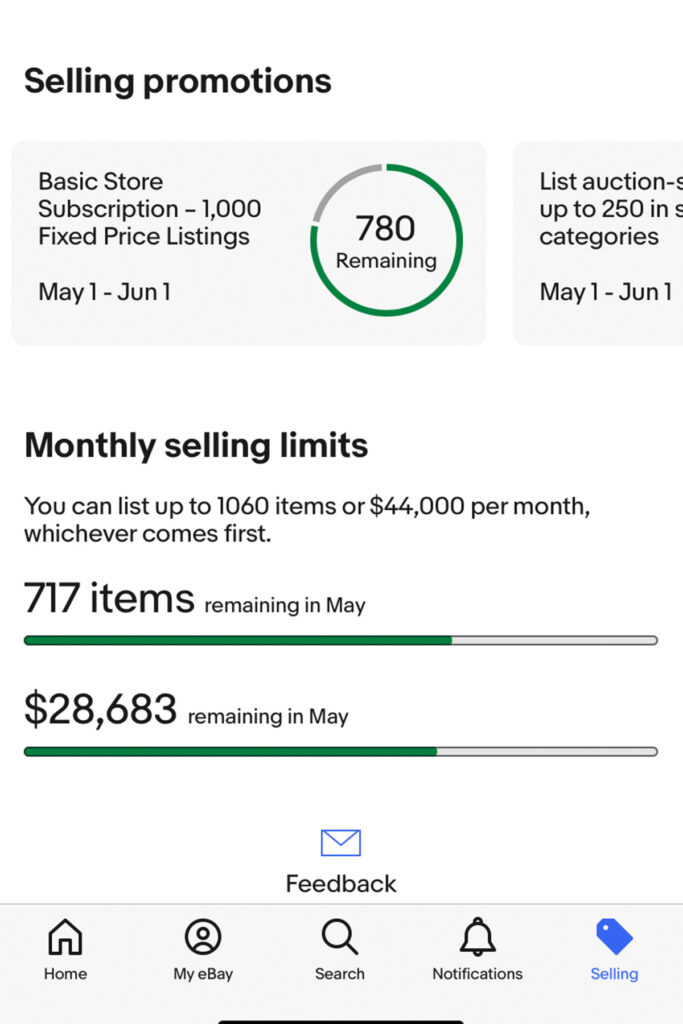
I advise new sellers to stick with the free plan while they learn more about strategies that lead to sales on eBay.
Mercari Subscription Fees
Along with no insertion fees, Mercari does not offer a subscription plan for a Mercari store. It is free to create and run a Mercari account, and all users are on the same, level playing field.
eBay Transaction Fees
Both eBay and Mercari have seller fees after the sale is completed, and they are fairly similar. However, eBay fees are less predictable. eBay takes a different percentage of the sale depending on the category that the item falls within, in addition to the final price of the sale.
Generally, the seller will pay anywhere between 3-15% of the sale price. For example, let’s look at books and magazines.
If a book or magazine sells for less than $7,500, eBay will take 14.95% of the sale as a final value fee. However, if the book or magazine sells for over $7,500, eBay will only take 2.35%.
In addition to the percentage taken from each sale, there is also a flat rate fee of $0.30 per order.
Mercari Transaction Fees
Mercari also breaks down its fees into two separate categories. One is a seller fee, and another is a transaction fee.
The seller fee on Mercari is 10% of the selling price, which is charged to the seller. This will directly be taken out of your final earnings from the sold item before they hit your available balance.
In addition to the selling fee, there is a payment processing fee of 2.9% plus a flat rate $0.50 per sale.
In total, Mercari sellers can expect to have around 13% of the final sale price go to Mercari. When compared to eBay, Mercari will have a better rate at times, but eBay will also win at times depending on the item type and price.
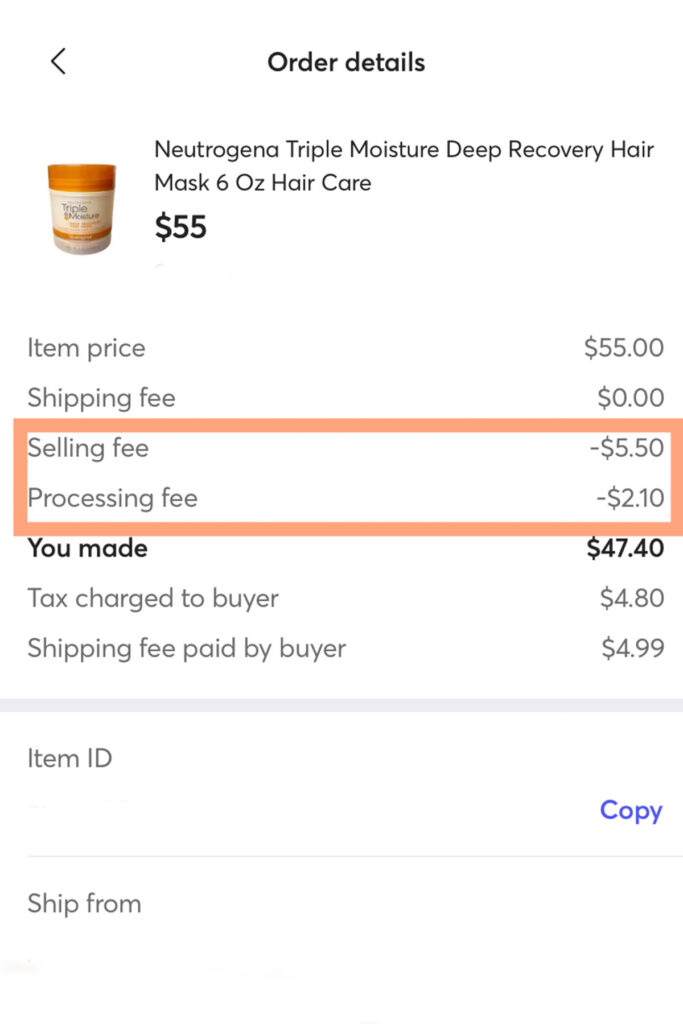
Best Items To Sell On Each Platform
Each platform has its strengths and weaknesses when it comes to its user base and the types of items that are able to be sold and perform well on each platform.
Items To Sell On eBay
eBay offers its sellers the opportunity to list items within a wide variety of categories. Sellers can list used clothing, shoes, accessories, electronics, used textbooks, household items, collector's items, to even cars and boats.
Items To Sell On Mercari
On Mercari, you can sell similar items, with the exception of larger items like cars and boats.
Either way, both platforms can be a great way for someone to start a side hustle to earn extra money or resell online full-time as their primary business and income.
Shipping
eBay Shipping
While payouts are automatic on eBay, shipping labels are not. Once the item sells, the seller must purchase their own shipping label.
Unlike Mercari, there is no automatic shipping label option. However, this can allow eBay sellers some flexibility and the potential to save money.
The easiest method is typically to purchase the shipping label directly from eBay. Plus, you can save money from USPS retail costs when shipping through eBay.
Once the item is paid for, eBay opens a link to purchase a shipping label for that item. Check to make sure the weight, package size, and shipping method are correct.
If it all checks out, purchase your label. You can choose from either printing your label on an 8x10 piece of paper (for you to cut out) or, if you have a label printer, you can directly print the 4x6 size.
You can also purchase a shipping label through a third-party site like Pirate Ship. Sometimes rates can be better than eBay’s shipping portal.
Plus, many third-party shipping sites have integrations with e-commerce platforms that directly upload the tracking number and mark the item as shipped for you.
No matter which way you want to ship, be sure to wait to send the item until it is paid for. The seller may purchase an item or accept an offer, but the sale is only complete once it is paid for. Don’t make the mistake of sending the item before it is paid for, and risk the buyer canceling the order.
Mercari Shipping
Mercari also allows sellers flexibility in shipping preferences. Sellers can choose between Mercari’s shipping methods or using their own label.
However, sellers have to be careful if they choose their own shipping label. Items shipped this way are not covered by Mercari’s seller protection policy if something were to happen.
For that reason, I solely use a Mercari label for all of my orders on that platform. Mercari offers sellers the ability to ship with the most popular parcel services. This includes USPS, UPS, and Fedex.
As a general rule, it makes the most sense to pick the cheapest shipping option. For smaller, lighter items this is typically USPS First Class mail.
Mercari also allows another interesting shipping option, and that is via Mercari local. With this service, a driver will pick up the item from your house and deliver it to the buyer.
This helps save time and money, and is generally safer than a meet-up with a stranger. Small items less than 50 pounds can be delivered for $15.99. Large items, like furniture, come with a delivery or shipping fee of $199.
Both Mercari and eBay offer the option to give buyers free shipping. Although the seller has to pay the shipping costs, it may help the items get more clicks and interest.
Getting Paid
Payouts On eBay
eBay offers many options to its sellers when it comes to payouts. Sellers can receive their funds for selling items directly to their bank account within the time frame they prefer.
Sellers can choose between weekly, biweekly, or monthly payout options. If you choose weekly, you will receive your payout every Thursday. Sellers on the bi-weekly schedule will receive their payout every second Tuesday.
Those that want to wait for a large lump sum and choose monthly will be paid on the first Tuesday of every month. As long as there is money available, eBay will release your earnings to you on your scheduled timeline without you even having to lift a finger.
eBay also has one of the quickest turnaround times for payment. Funds can become available as soon as 1 day following the confirmed and paid-for sale.
This is helpful for sellers who need their money quickly, as you can request a payout on demand. Payouts on demand allow sellers access to their funds sooner than their payout schedule.
eBay does not require sellers to wait until they are rated by their buyers to withdraw their earnings.
Payouts On Mercari
Mercari sellers, on the other hand, are required to manually withdraw their earnings. The money will appear in the Mercari seller’s balance after the sale is completed, and the buyer has provided a rating.
Once the earnings are in your Mercari app balance, you can choose between instant pay and direct deposit. Direct deposit is the slower of the two options, taking up to 5 business days, but it is free (for deposits over $10). Instant pay comes with a $3 fee.
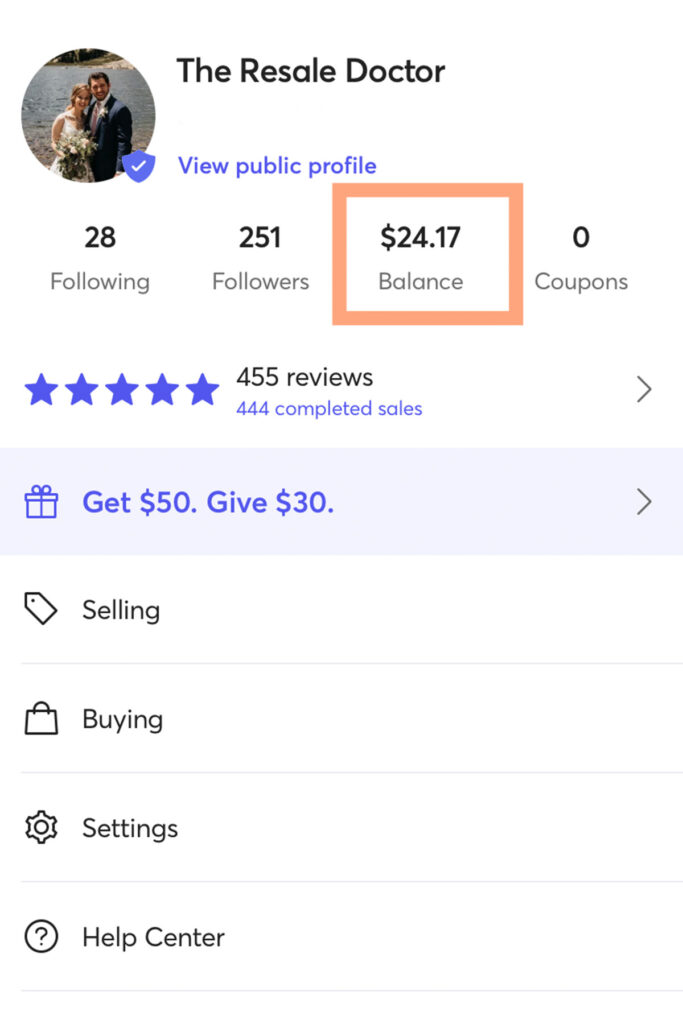
Returns
eBay Returns
eBay allows each individual seller to choose whether they want to accept returns or not. Many eBay sellers do, however, some do not.
In general, I have found that consumers do not want to ship their items back due to the inconvenience, and they will only ship back if the item really does not work out.
Plus, by offering return shipping, you give peace of mind to your potential buyers. For these reasons, I allow returns in my eBay store for all of my listings.
However, eBay sellers are able to set their own parameters on returns. Some sellers offer free returns. That is where the seller pays return shipping if the buyer requests to return the item.
Within my personal policy, I allow returns within 30 days. I have it outlined that the buyer pays for the return shipping.
Mercari Returns
Mercari allows returns with strict guidelines. The item must be not as described in the listing, not working properly, or must have been damaged during shipping.
If this is the case, a buyer will open a return case and the seller will be notified. Mercari will make the final decision if they award the return to the buyer.
If the item is not damaged and the return is approved, the buyer will send back the item to the seller. Neither the buyer or the seller have to pay for the return shipping.
If it is a scenario where it can be proven the item was damaged in transit, Mercari typically refunds the buyer's purchase while also releasing the earnings to the seller.
Mercari does not allow returns for items that just don’t fit, as eBay would.
How To Sell On Both Mercari and eBay
Okay so, hear me out. We are having this long debate about the pros and cons of Mercari vs eBay. We know that each has their own strengths and weaknesses.
But what if I told you it was incredibly easy to sell on both platforms at the same time? This can be accomplished with crosslisting.
The act of crosslisting is where sellers list all of their inventory items on multiple or all online platforms. This way, when your item is not on just one selling platform, more eyes and more types of consumers will be on your item.
The even better news is that you don’t have to spend time manually listing items one by one on each platform. That’s where the help of Vendoo comes in! It is the best way, along with being the easiest way of getting your item in front of more people.
Vendoo is a crosslisting platform that allows resellers to list their items to multiple platforms at once, including Mercari, eBay, Poshmark, Facebook Marketplace, Vestiaire Collective, Depop, Kidizen, Shopify, and more.
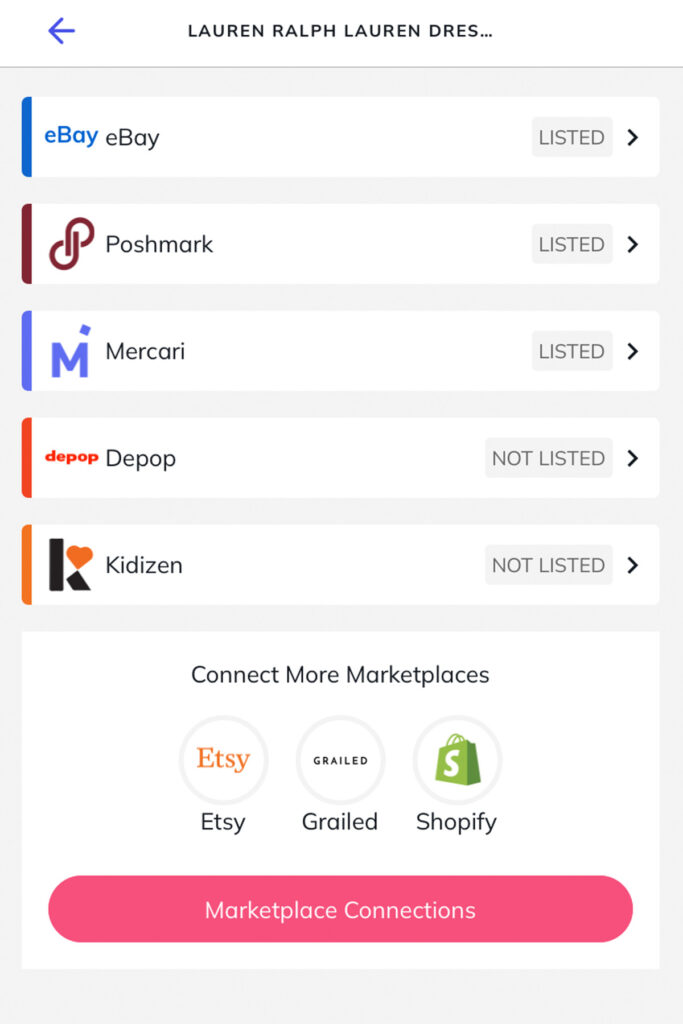
All you have to do is fill out a master listing form within Vendoo, and from there the information will disperse to each individual marketplace form. On each individual form, there are just a few more platform-specific fields to fill in.
Once you fill those specific fields out, you can list your item in multiple places. Plus, you don’t have to worry about selling an item twice. Once an item sells, you can input the sales details into Vendoo and Vendoo will delist the items from the other platforms.
If you’re wanting to give crosslisting a go, Vendoo offers a free trial for users to see how they like it. I think you’ll love it just as much as I do!
Recap
Now that we've broken down the battle of Mercari vs eBay, along with why you should use both, the choice is yours! As a recap, here are a few of the main points we went over.
Mercari strengths:
- Mercari local feature
- Quick and easy marketplace form
- No returns allowed
eBay strengths:
- Automatic payouts
- Much bigger customer base
- More affordable shipping
Which online marketplace is your favorite: Mercari or eBay? Comment below!


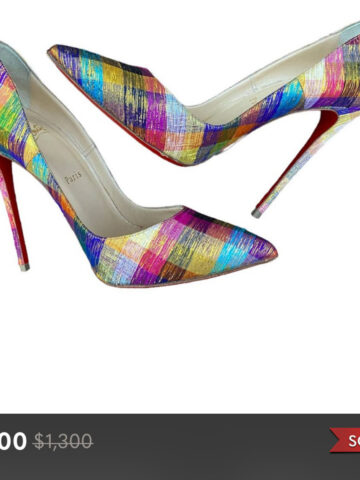



Leave a Reply